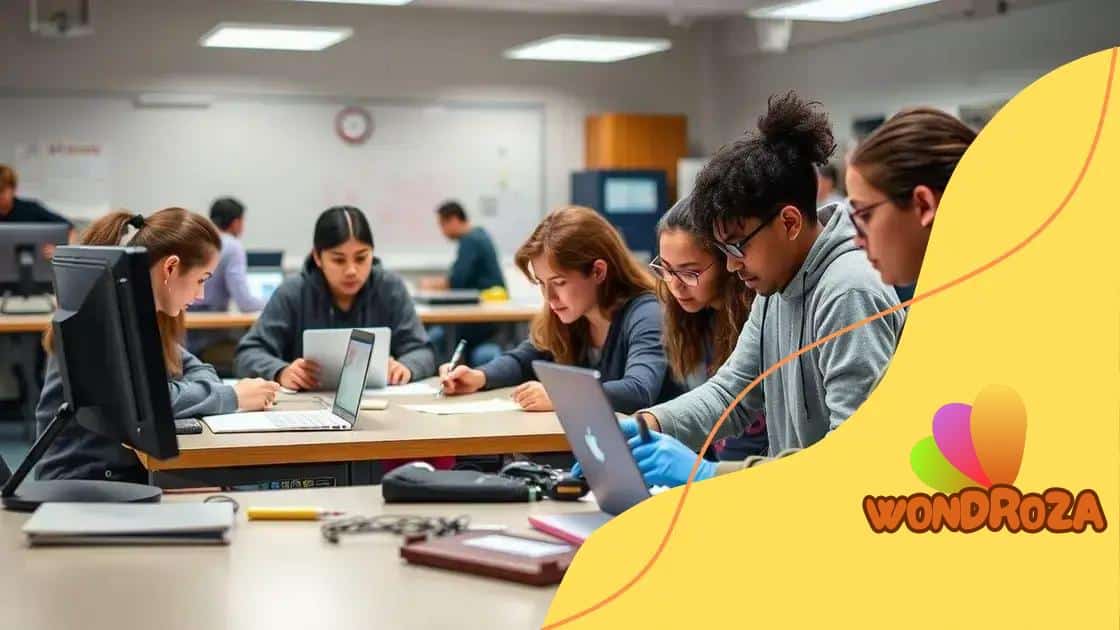The future of vocational education in the digital economy

The future of vocational education in the digital economy faces challenges such as outdated resources, stigma, and the need for industry collaboration, but embracing technology and strengthening partnerships can enhance training effectiveness.
The future of vocational education in the digital economy holds immense potential as it adapts to meet emerging needs. With rapid advancements in technology, how will these changes shape the educational landscape?
Understanding the digital economy
Understanding the digital economy is essential for grasping how our world is evolving. It’s a landscape rich with opportunities and challenges, shaped by technology and innovation.
The digital economy refers to economic activities that are enhanced or modified by digital technology. This includes online transactions, digital marketing, and the growing influence of social media. As we venture deeper into this age, the integration of technology in various sectors has changed the way we work.
Key Components of the Digital Economy
To properly navigate the digital economy, it’s vital to recognize its foundational elements.
- E-commerce: Buying and selling goods online is a major component, allowing businesses to reach a global audience.
- Digital Services: Services like streaming and online education have become prevalent, catering to diverse consumer needs.
- Data Analytics: Utilizing data effectively helps businesses make informed decisions and tailor their offerings.
Furthermore, understanding how digital platforms operate is crucial. Many companies leverage social media to connect with customers, build brand awareness, and drive sales. These platforms provide businesses with insights into consumer behavior, which is invaluable for strategic planning.
It’s also important to acknowledge that while the digital economy presents numerous advantages, it raises challenges related to privacy, security, and access. As more people engage with digital transactions, understanding these aspects becomes equally important.
Impacts of the Digital Economy on Vocational Education
The rise of the digital economy impacts vocational education significantly. Educational institutions are adapting their curricula to incorporate essential digital skills. This approach ensures that students are equipped for jobs that demand proficiency in technology.
As the demand for workforce skills evolves, vocational training programs are beginning to focus on technology-related fields. With frequent updates in technology, staying current with industry standards is essential.
In conclusion, grasping the intricacies of the digital economy is vital for success in today’s job market. By embracing change and acquiring new skills, individuals can thrive in an ever-evolving landscape.
Key skills for future job markets
In the ever-evolving job market, developing the right skills is crucial. As industries change, so do the key skills that employers seek. Understanding these skills can significantly enhance career prospects.
The digital economy demands a workforce that is well-equipped with both technical and soft skills. Technical skills are essential for engaging with tools and technologies, while soft skills foster collaboration and adaptability. Both areas are increasingly intertwined.
Essential Technical Skills
Here are some of the important technical skills in demand:
- Data Analysis: The ability to interpret and analyze data sets is critical as businesses rely on data-driven decisions.
- Coding and Programming: Familiarity with programming languages opens up opportunities in various fields, especially in tech and development.
- Digital Marketing: Knowledge in areas like SEO, content marketing, and social media can set candidates apart.
Alongside technical capabilities, employers also prioritize certain soft skills. These attributes help individuals effectively navigate team dynamics and workplace challenges.
Important Soft Skills
Some top soft skills sought in candidates include:
- Communication: The ability to clearly convey information, both verbally and in writing, is vital in any job.
- Problem-Solving: Employers seek individuals who can approach obstacles creatively and provide effective solutions.
- Adaptability: As industries shift, the ability to adjust to new challenges and requirements is crucial.
By focusing on these key skills, job seekers can position themselves favorably in the job market. The future holds exciting opportunities for those who are proactive in skill development.
Innovative teaching methods in vocational education

Innovative teaching methods in vocational education are transforming how students learn and prepare for the workforce. As industries evolve, education must adapt to provide relevant skills to students.
These new methods focus on engaging students through practical experience and technology. Hands-on learning allows students to apply their skills in real-world scenarios, making education more relevant to their future careers.
Project-Based Learning
One effective approach is project-based learning, where students work on real projects. This method encourages teamwork and problem-solving while promoting deeper understanding.
- Real-world applications: Students can connect theory to practice, enhancing retention.
- Collaboration: Working in teams mimics workplace environments, preparing students for future jobs.
- Critical thinking: Students develop analytical skills by tackling complex projects.
Another innovative approach is the use of technology in teaching. Digital tools enhance learning experiences and provide access to a wealth of resources.
Blended Learning
Blended learning combines traditional classroom methods with online education. This approach gives students flexibility and allows for personalized learning experiences.
- Self-paced learning: Students can learn at their own speed, reviewing concepts as needed.
- Access to resources: Online platforms provide supplementary materials and interactive activities.
- Increased engagement: Multimedia resources make learning more enjoyable and interesting.
Furthermore, incorporating mentorship programs into vocational education helps bridge the gap between education and employment. Students benefit from guidance provided by industry professionals, gaining insights into their chosen fields.
These innovative teaching methods in vocational education not only enhance student engagement but also prepare them for the challenges of the modern workforce. By emphasizing practical skills and collaboration, educators can help students succeed in their careers.
The role of technology in vocational training
The role of technology in vocational training has grown immensely. With advancements in digital tools, education can now be more interactive and effective. Technology enhances learning experiences and prepares students for modern workplaces.
One significant aspect is the use of online learning platforms. These platforms provide flexibility, allowing students to access materials at their convenience. This flexibility supports different learning styles and paces.
Simulation and Virtual Reality
Another innovative use of technology is the implementation of simulations and virtual reality (VR). These tools create realistic scenarios where students can practice skills safely.
- Hands-on experience: VR allows students to engage in scenarios they might encounter in actual jobs, improving confidence.
- Safe learning environment: Mistakes in a simulation don’t have real-world consequences, enabling students to learn from errors.
- Enhanced engagement: Interactive programs capture students’ attention, making learning enjoyable.
Moreover, technology enables students to engage with instructors and peers through online forums and discussion groups. This interaction fosters collaboration and helps students develop essential networking skills.
Continuous Learning and Skill Development
Technology also supports the concept of continuous learning. With access to online resources, individuals can update their skills as industries change. They can enroll in short courses, webinars, and workshops without disrupting their schedules.
- On-demand resources: Students can review lessons and materials at any time, reinforcing their understanding.
- Wide range of topics: Online platforms offer courses across various fields, catering to different career paths.
- Community connections: Engaging with online communities allows students to share knowledge and experiences.
In summary, the integration of technology in vocational training significantly enhances educational outcomes. By embracing these advancements, educators can better prepare students for successful careers in a rapidly changing world.
Challenges facing vocational education today
Challenges facing vocational education today are significant and multifaceted. As the job market continually changes, vocational education programs must adapt to meet the demands of both students and employers.
One of the primary challenges is the rapid advancement of technology. Many vocational programs struggle to keep up with the latest tools and techniques required in various industries. This gap can leave students ill-prepared for the workforce.
Funding and Resources
Another major issue is the lack of funding and resources for vocational education. Schools often face budget cuts, resulting in limited access to necessary equipment and training materials.
- Outdated equipment: Students may not have access to the latest tools, making it hard for them to gain relevant skills.
- Inadequate facilities: Many programs lack adequate space for hands-on training, reducing the effectiveness of learning.
- Limited course offerings: Without funding, schools may not be able to provide a diverse range of training programs.
Moreover, there is often a stigma associated with vocational education. Many people view it as less valuable compared to traditional college paths. This perception can deter students from pursuing vocational training, limiting their career options.
Industry Collaboration
Collaboration between academia and industry is essential, yet it is often lacking. Vocational programs need to connect more effectively with local businesses to ensure that training aligns with current workforce needs.
- Curriculum relevance: Engaging with industry partners can help keep curricula up-to-date with employer expectations.
- Internship opportunities: Stronger ties with businesses can provide students with valuable hands-on experience.
- Feedback mechanisms: Regular feedback from employers helps refine training programs for better outcomes.
Addressing these challenges is crucial for the future of vocational education. By enhancing resources, changing perceptions, and fostering industry collaboration, vocational training can better prepare students for success in their careers.
\n
| 💡 Topics | 📈 Key Points |
|---|---|
| Funding | Need for better resources to train students. |
| Technology | Implement new tech to enhance learning. |
| Stigma | Changing perceptions about vocational education. |
| Industry Links | Building stronger partnerships with local businesses. |
| Student Support | Providing mentorship and career guidance. |
\n
\n
FAQ – Frequently Asked Questions about Vocational Education Challenges
What are the main challenges facing vocational education today?
Key challenges include outdated resources, lack of funding, stigma associated with vocational paths, and the need for stronger industry collaboration.
How does technology impact vocational training?
Technology enhances vocational training by providing interactive learning experiences, access to online resources, and tools like simulations and virtual reality.
Why is there a stigma around vocational education?
The stigma often comes from societal perceptions that undervalue vocational paths compared to traditional college routes, leading to fewer students pursuing these programs.
How can industry partnerships benefit vocational education?
Stronger partnerships with local businesses can ensure training aligns with actual workforce needs, providing students with relevant skills and real-world experience.





